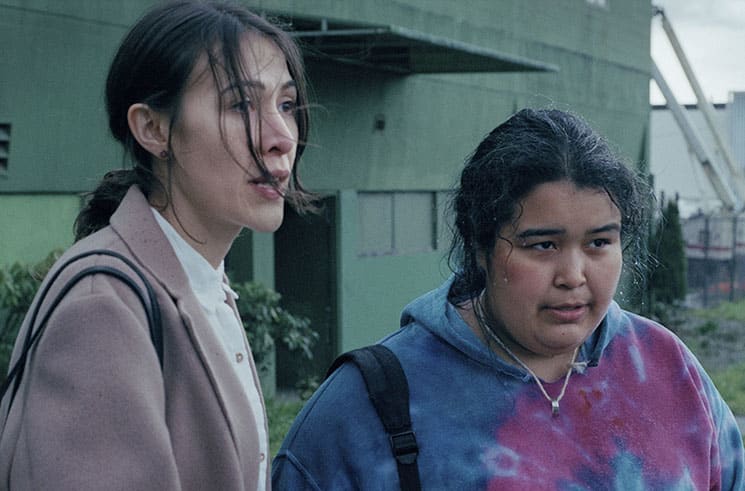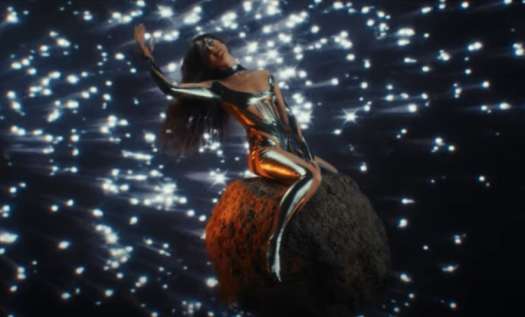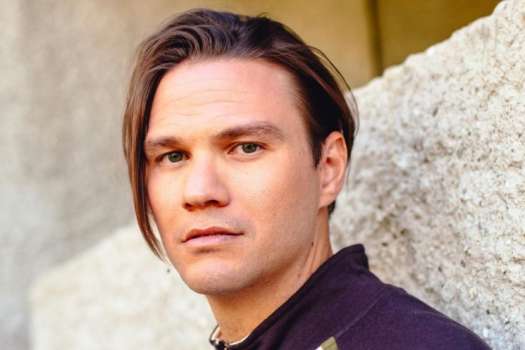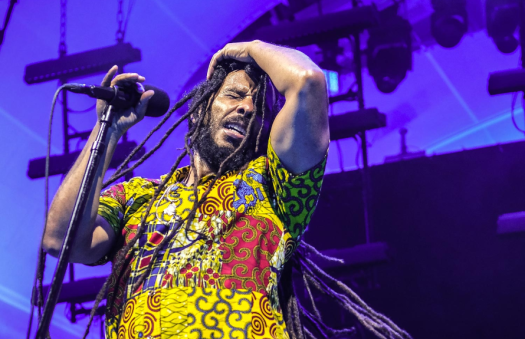A specific significance of this film's title, The Body Remembers When the World Broke Open, might be lost on me. To pick out the pair of words "broke open," though, they suggest a world once closed and now irrevocably available to the eye. Writers and directors Elle-Máijá Tailfeathers and Kathleen Hepburn break open the worlds of two women, people with different backgrounds and experiences, allowing them to see and consider another life and their own.
The meeting of the two leads comes from a moment of unexpected intersection. Áila (Tailfeathers) is coming from a doctor's office, where she's been given an IUD. On the way to her Vancouver home, she sees Rosie (Violet Nelson) standing in the rain, frozen in place, without shoes, while a man across the street yells at her angrily. With obvious concern, Áila asks Rosie if she would like to come home with her and, rushing as the man continues to shout, they go off, Áila taking Rosie's hand.
From here, the film progresses in real time as the two unpack their lives. They are both Indigenous women, Áila having Blackfoot and Sami heritage, while Rosie comes from the Kwakwaka'wakw peoples. Starting from that foundation, their differences are already drawing clear lines. When we come to Áila's home, it's a far cry from the apartment we saw Rosie in earlier. Every exterior wall is opened up with windows, seating spaces are arranged throughout, and a well-kept record player has Joni Mitchell cued up. Áila is financially privileged, but the divides run deeper to their Indigenous bona fides, when Rosie passingly calls Áila's heritage into question in a heated moment.
Áila's concerns in her life of relative ease aren't pressing; Rosie can't ignore her own and is presented with no easy options. Her "lover," as she prefers he be called, is abusive, and she lives with him and his mother in an apartment where Rosie suffers for her slights, small as well as imagined. She's also pregnant and showing, with the intention of keeping the child, who she already loves deeply. As far as she sees it, she has to stay put with her lover in Vancouver; every path out still too difficult to conceive.
Body is deeply focused on this pair. As we're moving through Vancouver, we're following them. If we're in a space, we're watching their actions or their reactions. (Tailfeathers and Nelson are both terrific onscreen listeners.) When others are present, telling stories or jokes, doing anything really, we're still locked in on one of the duo. Only one at a time, though — it's rare in the film that they share focus in a moment together, the film instead tunnelling in on one or the other. While they're certainly co-leads, they aren't in this together or sharing an experience — they're seeing each other's perspectives.
They may have lived side by side for years without noticing. The film opens on a bus, a handrail in the foreground with Rosie in focus in the background. At one moment, Áila passes by, unremarked upon. The two are invisible to each other at first before their stories open to each other. In style and content, Body eases into the grounds they show each other and occasionally share.
In each of their conversations and the actions they take as described above, you might see potential talking points, stabs at the events of our time. Domestic abuse, class and privilege, Indigenous experiences — Body touches on aspects of these and more without leaving them as bare as a general discussions of issues. The film easily follows Áila and Rosie step by step, the action and rests illustrating two characters who intersect these topics but are characters in themselves still.
The film's roaming camera finds a consistent visual aesthetic, moving naturally through real urban environments with few, if any by the looks of it, instances of additional lighting. The directors, along with cinematographer Norm Li, have accomplished a feat, drawing together the feeling of a rainy West coast day as seen in a muted safe house, Áila's apartment, and Rosie's claustrophobic home, among other locations that take on looks that are emotionally expressive without taking away from the film's muted realism.
The Body Remembers When the World Broke Open has so many long, long shots, interesting in a time when the one-shot movie is again being discussed. The balance here is struck by purpose-driven, smart filmmaking, wielding a lengthy take or a cut where it needs to be done to keep the audience in the conversation with the film's compelling leads.
(levelFILM)The meeting of the two leads comes from a moment of unexpected intersection. Áila (Tailfeathers) is coming from a doctor's office, where she's been given an IUD. On the way to her Vancouver home, she sees Rosie (Violet Nelson) standing in the rain, frozen in place, without shoes, while a man across the street yells at her angrily. With obvious concern, Áila asks Rosie if she would like to come home with her and, rushing as the man continues to shout, they go off, Áila taking Rosie's hand.
From here, the film progresses in real time as the two unpack their lives. They are both Indigenous women, Áila having Blackfoot and Sami heritage, while Rosie comes from the Kwakwaka'wakw peoples. Starting from that foundation, their differences are already drawing clear lines. When we come to Áila's home, it's a far cry from the apartment we saw Rosie in earlier. Every exterior wall is opened up with windows, seating spaces are arranged throughout, and a well-kept record player has Joni Mitchell cued up. Áila is financially privileged, but the divides run deeper to their Indigenous bona fides, when Rosie passingly calls Áila's heritage into question in a heated moment.
Áila's concerns in her life of relative ease aren't pressing; Rosie can't ignore her own and is presented with no easy options. Her "lover," as she prefers he be called, is abusive, and she lives with him and his mother in an apartment where Rosie suffers for her slights, small as well as imagined. She's also pregnant and showing, with the intention of keeping the child, who she already loves deeply. As far as she sees it, she has to stay put with her lover in Vancouver; every path out still too difficult to conceive.
Body is deeply focused on this pair. As we're moving through Vancouver, we're following them. If we're in a space, we're watching their actions or their reactions. (Tailfeathers and Nelson are both terrific onscreen listeners.) When others are present, telling stories or jokes, doing anything really, we're still locked in on one of the duo. Only one at a time, though — it's rare in the film that they share focus in a moment together, the film instead tunnelling in on one or the other. While they're certainly co-leads, they aren't in this together or sharing an experience — they're seeing each other's perspectives.
They may have lived side by side for years without noticing. The film opens on a bus, a handrail in the foreground with Rosie in focus in the background. At one moment, Áila passes by, unremarked upon. The two are invisible to each other at first before their stories open to each other. In style and content, Body eases into the grounds they show each other and occasionally share.
In each of their conversations and the actions they take as described above, you might see potential talking points, stabs at the events of our time. Domestic abuse, class and privilege, Indigenous experiences — Body touches on aspects of these and more without leaving them as bare as a general discussions of issues. The film easily follows Áila and Rosie step by step, the action and rests illustrating two characters who intersect these topics but are characters in themselves still.
The film's roaming camera finds a consistent visual aesthetic, moving naturally through real urban environments with few, if any by the looks of it, instances of additional lighting. The directors, along with cinematographer Norm Li, have accomplished a feat, drawing together the feeling of a rainy West coast day as seen in a muted safe house, Áila's apartment, and Rosie's claustrophobic home, among other locations that take on looks that are emotionally expressive without taking away from the film's muted realism.
The Body Remembers When the World Broke Open has so many long, long shots, interesting in a time when the one-shot movie is again being discussed. The balance here is struck by purpose-driven, smart filmmaking, wielding a lengthy take or a cut where it needs to be done to keep the audience in the conversation with the film's compelling leads.




